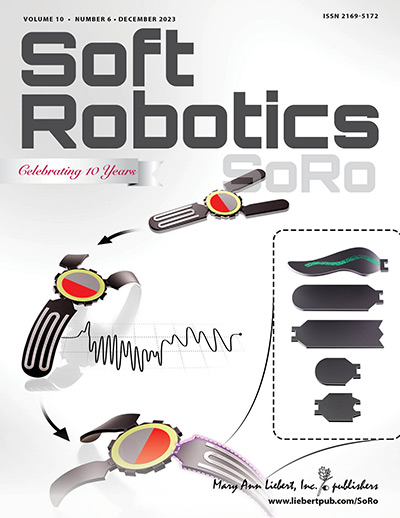A Soft Amphibious Turtle Robot with Flexibility and Omnidirectional Motion Ability Actuated by Multiple Bionic Muscles.
IF 6.1
2区 计算机科学
Q1 ROBOTICS
引用次数: 0
Abstract
Amphibious robots have great application potential in many unstructured task scenarios, such as environmental monitoring, resource exploration, and maritime rescue, due to their cross-medium movement capabilities and adaptability to multiple environments. As a typical representative of amphibians, sea turtles can not only crawl on land but also have excellent underwater movement ability, which is an important source of inspiration for amphibious bionic robots. However, due to a lack of high-performance soft actuators, suitable bionic structure designs, and effective control methods, most of the current bionic turtle robots actuated by smart materials can only demonstrate movement in a single medium (e.g., swimming in water or crawling on land). Here, an amphibious turtle robot actuated by bionic muscles that can achieve effective movements in two media was designed. To enhance the amphibious ability of the turtle robot, a cylindrical dielectric elastomer actuator that can adapt to a variety of environments is designed with a maximum bidirectional deformation (±65°) and a high output force (∼80 mN). By optimizing the motion trajectory of the fins and programming the phase control of multiple bionic muscles, the robot's maximum swimming speed reaches 0.4 BL/s. In addition, the robot can realize different motion modes, such as forward, backward, lateral movement, turning, and crawling. Finally, the high mobility and environmental adaptability of the turtle robot are demonstrated in an L-shaped swimming passage and in two mediums (transition from land to water). This work not only improves the motion ability of bionic amphibious robots but is also useful for the motion control of other bionic robots with multiple actuators.一种由多块仿生肌肉驱动的具有柔性和全方位运动能力的两栖乌龟机器人。
水陆两栖机器人具有跨介质运动能力和多环境适应性,在环境监测、资源勘探、海上救援等非结构化任务场景中具有很大的应用潜力。海龟作为两栖动物的典型代表,不仅可以在陆地上爬行,而且具有出色的水下运动能力,这是两栖仿生机器人的重要灵感来源。然而,由于缺乏高性能的软致动器、合适的仿生结构设计和有效的控制方法,目前大多数由智能材料驱动的仿生龟机器人只能在单一介质中进行运动(例如在水中游泳或在陆地上爬行)。本文设计了一种由仿生肌肉驱动的两栖龟机器人,该机器人可以在两种介质中进行有效的运动。为了增强乌龟机器人的两栖能力,设计了一种可适应多种环境的圆柱形介电弹性体致动器,具有最大双向变形(±65°)和高输出力(~ 80 mN)。通过优化鳍片运动轨迹和对多个仿生肌肉的相位控制进行编程,使机器人的最大游泳速度达到0.4 BL/s。此外,机器人还可以实现前进、后退、横向移动、转弯、爬行等不同的运动模式。最后,在l型游泳通道和两种介质(从陆地到水的过渡)中展示了龟机器人的高机动性和环境适应性。这项工作不仅提高了仿生水陆机器人的运动能力,而且对其他多作动器仿生机器人的运动控制也有借鉴意义。
本文章由计算机程序翻译,如有差异,请以英文原文为准。
求助全文
约1分钟内获得全文
求助全文
来源期刊

Soft Robotics
ROBOTICS-
CiteScore
15.50
自引率
5.10%
发文量
128
期刊介绍:
Soft Robotics (SoRo) stands as a premier robotics journal, showcasing top-tier, peer-reviewed research on the forefront of soft and deformable robotics. Encompassing flexible electronics, materials science, computer science, and biomechanics, it pioneers breakthroughs in robotic technology capable of safe interaction with living systems and navigating complex environments, natural or human-made.
With a multidisciplinary approach, SoRo integrates advancements in biomedical engineering, biomechanics, mathematical modeling, biopolymer chemistry, computer science, and tissue engineering, offering comprehensive insights into constructing adaptable devices that can undergo significant changes in shape and size. This transformative technology finds critical applications in surgery, assistive healthcare devices, emergency search and rescue, space instrument repair, mine detection, and beyond.
 求助内容:
求助内容: 应助结果提醒方式:
应助结果提醒方式:


